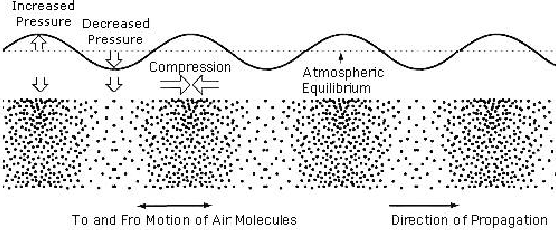
Next: Sound sources and attenuation Up: 11. Audio Previous: 11. Audio Contents Index
 |
This section parallels many concepts from Chapter 4, which covered the basic physics of light. Sound wave propagation is similar in many ways to light, but with some key differences that have major perceptual and engineering consequences. Whereas light is a transverse wave, which oscillates in a direction perpendicular to its propagation, sound is a longitudinal wave, which oscillates in a direction parallel to its propagation. Figure 11.1 shows an example of this for a parallel wavefront.
Sound corresponds to vibration in a medium, which is usually air, but could also be water, or any other gases, liquids, or solids. There is no sound in a vacuum, which is unlike light propagation. For sound, the molecules in the medium displace, causing variations in pressure that range from a compression extreme to a decompressed, rarefaction extreme. At a fixed point in space, the pressure varies as a function of time. Most importantly, this could be the pressure variation on a human eardrum, which is converted into a perceptual experience. The sound pressure level is frequently reported in decibels (abbreviated as dB), which is defined as
| (11.1) |
Sound waves are typically produced by vibrating solid materials, especially as they collide or interact with each other. A simple example is striking a large bell, which causes it to vibrate for many seconds. Materials may also be forced into sound vibration by sufficient air flow, as in the case of a flute. Human bodies are designed to produce sound by using lungs to force air through the vocal cords, which causes them to vibrate. This enables talking, singing, screaming, and so on.